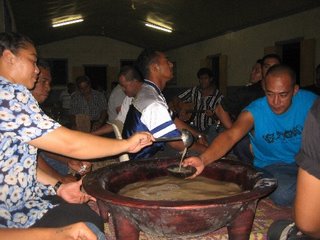Kava Culture

kava (piper methysticum): 1 a pepper species that is ubiquitous in the South
Pacific; 2 a liquid strained from the ground root of the kava plant, when
consumed causes a mouth-numbing and mild tranquilizing affect. 3 the lifeblood
of the Kingdom of Tonga.
Where there is life in Tonga’s 171 sparsely populated islands, there is kava. From bestowing a royal title, to starting a small business to cracking a lewd joke at a Philadelphian Peace Corps Volunteer, kava is there.
The powdered root of the kava plant is poured into a sifter that is submerged in a drum of water. Strained like a giant tea bag, the water turns into a murky brown fluid packed with 12 to 14 chemicals of an alkaloid nature.
Sitting cross-legged, I peer out over my 30th kava-filled half-coconut shell, trying to delay the inevitable next round. I see a circle of 15 men—aged 18 to 80—some involved in serious conversations, others—the lucky ones—putting on their best face to talk to the toua (woman who serves kava), most, making fun of that person’s attempt at flirtation, all while being serenaded with traditional Tongan music accompanied by guitar and ukulele.
Across the outdoor patio, two to three other “kava circles,” are formed of the same dynamic. Like I do two nights each week, I drink that cup—the kava that broke the palangi’s back, if you will—and haziness sets over my mind, with a wobble to my legs.
The next morning, when I’m overcome with lethargy until noon—the dreaded kava hangover—I reflect on Tonga’s “kava culture,” and why two days later, I’ll rejoin it.
Kava Philanthropy: kava groups are the primary fundraiser in Tonga. At least two nights each week, my village of Makave will hold a kava fundraiser, with beneficiaries ranging from the Makave Youth Group’s partner project with Main Line Life, Tapes for Tonga, to paying school fees for children with financial needs, to helping pay a villager’s medical expenses.
Kava Conversation: kava circles are also a chance to study the language. At the beginning of my service, four hours was a long time to sit in a state of cluelessness. However, I learned as I listened. As my language skills improved, I was able to ascertain when laughs were made at my expense. Now 10-months into my service, I’m able to go on the offensive, boasting an arsenal of Tongan kava jokes.
Kava Culture: When not poking fun at one another, my Tongan friends describe the culture and what it was like for them growing up. Think of the old “walking 10-miles barefoot through snow to school” story. Forget about the snow, but the Tongan version does include bare feet.
Kava Formality: kava is an opportunity to see the formality of Tongan life. At a kava party last fall, I sat with 10 members of the Makave Youth Group, who donned shorts and tank tops. Our village noble Tu’i ‘Afitu (formerly Lolo Mana’ia, the eldest son of the late Tu’i ‘Afitu) appeared in the door. There followed a frenzy of activity: men changing into formal Tongan clothing, youth running outdoors to clean the noble’s kava cup, and all returning to rearrange the circle—with the noble at the head of the circle, surrounded by his matāpules (talking chiefs) and then individuals according to rank, with the lowest man serving the kava. No where is Tongan hierarchy more evident than in a kava circle.
Kava “Knighting”: kava is to Tonga as the sword is to Great Britain, the bearer of titles. Before Lolo Mana’ia officially became Tu’i ‘Afitu, he drank one cup of kava as a symbol of his commitment to being a noble. The ceremony was formal, conducted outdoors in front of hundreds of our fellow Tongans. Filled with Tongan pomp and circumstance, dozens of pigs were sacrificed and huge underground ovens were dug to prepare food. The ancient ceremony included a dramatic performance about the making of kava from plant to powder to liquid.
In a similar ritual on the final day of mourning for the late noble, I followed in Lolo Mana’ia’s footsteps, shedding my Tongan name “Sosifa,” for the matāpule title “ ‘Afitu,” with a cup of Tonga’s be-all-end-all.
Kava has become an oxymoron to me. A kava haze is followed by language and cultural understanding; a morning kava hangover, followed by the bestowing of a title in the afternoon. There’s much to be gained through drinking kava, yet productivity to be lost in the lethargy of the morn. Perhaps as a solution, we can “Tonga-fy” the old adage: after every two cups forward, we should give one cup back…

